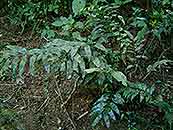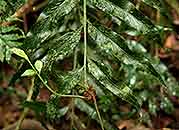Asplenium gemmiferum Schrad.
Synonyms |
Asplenium macrolobium Peter |
|---|---|
Common name |
|
Description |
Rhizome erect, up to 30 mm thick; rhizome scales 9-14 x 2-3 mm, dark brown, lanceolate in outline, fimbriate, apex gradually tapering to a point. Fronds tufted, arching, proliferous, gemma born towards the apex of the lamina at the base of the apical segment. Stipe up to 30 cm, grey-green, densely clothed with scales at first, becoming subglabrous with age. Lamina up to 1m long and up to 25 cm wide, pinnate, with basal pinnae slightly reduced, terminal pinnae similar to other, lanceolate in outline. Pinnae 6-12 pairs, 10-19 x 2-5.2 cm, alternate, lanceolate to narrow elliptic in outline, subglabrous below, margins regularly crenate, base unequally wedge-shaped, apex gradually tapering to a point. Rhachis matt-grey-green, not winged or narrowly winged in upper half, subglabrous as for stipe. Sori linear, up to 19 mm long, set at 45 degrees to the midrib; indusium linear, entire, membranous, c. 1 mm wide. |
Notes | Differs from similar species by having gemmiferous fronds and subentire or crenate margins. |
Derivation | gemmiferum: bearing gemma, the fern has plantlets (buds) below the apex of the fronds. |
Habitat | Deeply shaded stream banks in evergreen forest. |
Distribution worldwide | See African distribution. |
Distribution in Africa |
Burundi, Cameroon, Congo, Dem. Republic of Congo, Equatorial Guinea (incl. Bioko), Kenya, Malawi, Mozambique, South Africa, Tanzania , Uganda, Zimbabwe. |
Growth form |
Epiphytic, lithophytic, terrestrial. |
Literature |
|



